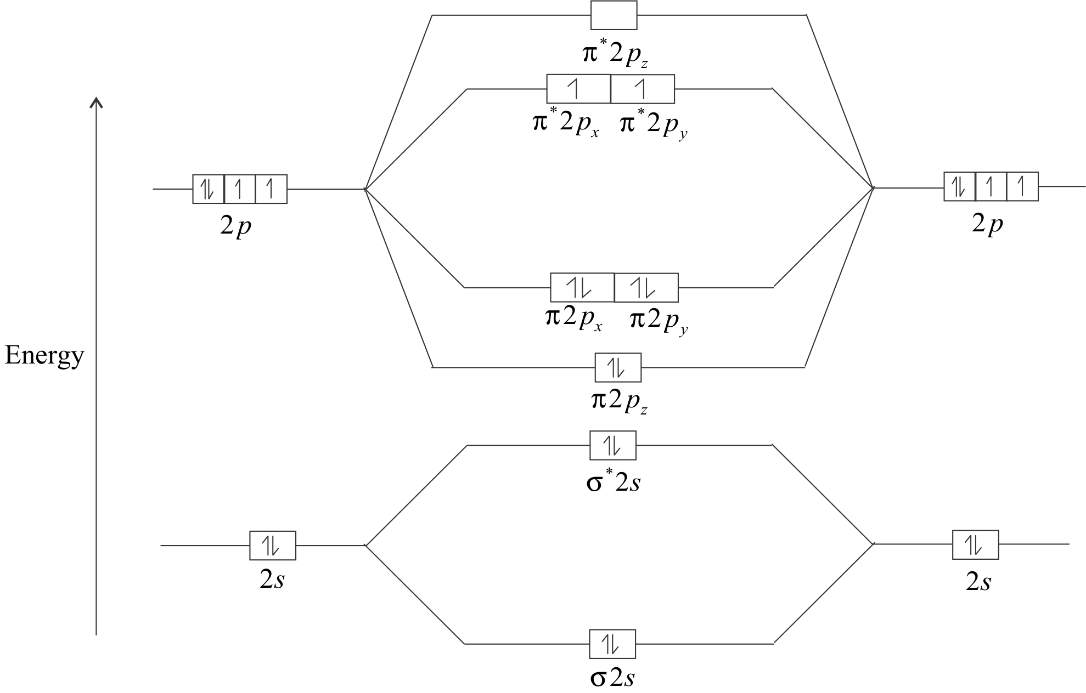
Oxygen molecule is:
(A). diamagnetic with no unpaired electrons
(B). diamagnetic with two paired electrons
(C). paramagnetic with two unpaired electrons
(D). paramagnetic with no paired electrons
Answer
557.4k+ views
Hint: According to the molecular orbital theory, the molecular orbital structure of oxygen contains two unpaired electrons in the antibonding orbitals. The molecule having unpaired electrons in the configuration is known as paramagnetic in nature.
Complete step by step answer:
The electronic configuration of oxygen (atomic number$z = 8$ ) in the ground state is:

As each oxygen atom has light electron so, the electronic configuration of oxygen molecule is:
${O_2} \to 1{S^2}{\sigma ^*}1{S^2}\sigma 2{S^2}{\sigma ^*}2{S^2}\pi 2{P_2}^2\pi 2{P_x}^2 = \pi 2P{y^2}$
${\pi ^*}2P{x^1} = {\pi ^*}2P{y^1}$
The bond – order of ${O_2}$ is two.
$\operatorname{Bond} order{\text{ = }}\dfrac{{{N_b} - {N_a}}}{2} = \dfrac{{8 - 4}}{2} = 2$
Bond – order shows the number of electrons present in anti – bonding molecular orbitals.
${O_2}$Has two bonds, one is sigma bond and other is pi-bonded.
The energy diagram of ${O_2}$molecule is:

The electrons in ${\pi ^*}2Px$ and ${\pi ^*}2Py$ remain unpaired. So, there are two unpaired electrons in ${O_2}$. Hence, it is paramagnetic in nature with two unpaired electrons.
So, the correct answer is Option C .
Additional information:
The molecular theory or MOT is based on chemical bonding and it was developed by F. Hund and R.S. Mulliken. It describes the structure and the properties of different molecules. The molecular orbital theory proved to be good as compared to valence bond theory because valence bond theory failed to explain how the molecules contain two or more than two equivalent bonds if in case their bond order lies in between single and double bonds.
Note: The molecular orbital theory can explain the existence of molecules on the basis of bond order, this holds good for diatomic molecules but not for the polyatomic molecules. Also, only with the help of molecular orbital theory one cannot describe the geometry and shape of the molecule.
Complete step by step answer:
The electronic configuration of oxygen (atomic number$z = 8$ ) in the ground state is:

As each oxygen atom has light electron so, the electronic configuration of oxygen molecule is:
${O_2} \to 1{S^2}{\sigma ^*}1{S^2}\sigma 2{S^2}{\sigma ^*}2{S^2}\pi 2{P_2}^2\pi 2{P_x}^2 = \pi 2P{y^2}$
${\pi ^*}2P{x^1} = {\pi ^*}2P{y^1}$
The bond – order of ${O_2}$ is two.
$\operatorname{Bond} order{\text{ = }}\dfrac{{{N_b} - {N_a}}}{2} = \dfrac{{8 - 4}}{2} = 2$
Bond – order shows the number of electrons present in anti – bonding molecular orbitals.
${O_2}$Has two bonds, one is sigma bond and other is pi-bonded.
The energy diagram of ${O_2}$molecule is:

The electrons in ${\pi ^*}2Px$ and ${\pi ^*}2Py$ remain unpaired. So, there are two unpaired electrons in ${O_2}$. Hence, it is paramagnetic in nature with two unpaired electrons.
So, the correct answer is Option C .
Additional information:
The molecular theory or MOT is based on chemical bonding and it was developed by F. Hund and R.S. Mulliken. It describes the structure and the properties of different molecules. The molecular orbital theory proved to be good as compared to valence bond theory because valence bond theory failed to explain how the molecules contain two or more than two equivalent bonds if in case their bond order lies in between single and double bonds.
Note: The molecular orbital theory can explain the existence of molecules on the basis of bond order, this holds good for diatomic molecules but not for the polyatomic molecules. Also, only with the help of molecular orbital theory one cannot describe the geometry and shape of the molecule.
Recently Updated Pages
Why are manures considered better than fertilizers class 11 biology CBSE

Find the coordinates of the midpoint of the line segment class 11 maths CBSE

Distinguish between static friction limiting friction class 11 physics CBSE

The Chairman of the constituent Assembly was A Jawaharlal class 11 social science CBSE

The first National Commission on Labour NCL submitted class 11 social science CBSE

Number of all subshell of n + l 7 is A 4 B 5 C 6 D class 11 chemistry CBSE

Trending doubts
10 examples of friction in our daily life

One Metric ton is equal to kg A 10000 B 1000 C 100 class 11 physics CBSE

Difference Between Prokaryotic Cells and Eukaryotic Cells

1 Quintal is equal to a 110 kg b 10 kg c 100kg d 1000 class 11 physics CBSE

State the laws of reflection of light

Explain zero factorial class 11 maths CBSE




